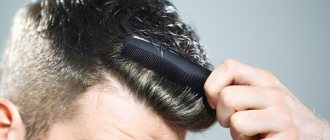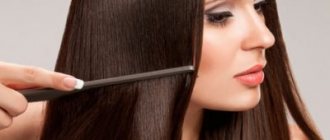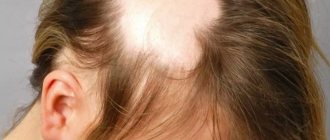Baldness or excessive hair loss, which over time leads to the appearance of pronounced bald spots mainly on the head, can affect almost anyone, regardless of their gender, age or social status. There is, of course, a stereotype (and it is justified, but only partly) that mainly men are susceptible to baldness, but this is not the absolute truth. Severe hair loss can occur in women and even children.
Most often, this is a reversible process and, if the factors causing hair loss are identified in a timely manner and corrected with the help of well-chosen treatment, then complete baldness can be avoided and, moreover, normal hair growth can be successfully restored.
Mechanism of appearance of AGA
Two types of hair can grow on our heads: regular and androgen-dependent, which die under the influence of the active form of the male sex hormone testosterone - dihydrotestosterone (DHT). DHT, in turn, is formed under the influence of the enzyme 5-alpha reductase, which is found in hair follicles and sebaceous glands. It is intrafollicular dihydrotestosterone that is the source of hair loss: it causes a strong, prolonged spasm of the vessels feeding the follicles, disrupts protein synthesis and, as a result, causes degeneration of the hair bulb and hair. In this case, the level of testosterone in the body may be normal or even reduced. Because AGA is not a disease, but a feature of the body.
The female body also contains testosterone and 5-alpha reductase, but in smaller quantities than the male body. In addition, estrogens predominate, and if the hormonal balance is not disturbed, the manifestation of AGA will become noticeable in a woman only during menopause. If hair loss began before menopause and at a young age, this is often associated with hormonal imbalance (diseases of the adrenal glands, ovaries, pituitary gland).
However, sex hormones do not always suppress or enhance hair growth. The effect of androgens or estrogens on hair is determined by the presence of special receptors on the surface of hair follicle cells. These receptors are activated by sex hormones and stimulate or block hair growth. The main cause of hair loss in AGA is either increased activity of 5-alpha reductase or increased sensitivity of hair follicle cell receptors to DHT. Therefore, there is no direct connection between age and AGA. Trichologists note that in the last few years the age of the main flow of patients is not 50-60 years old, but 25-35 years old. Moreover, cases of treatment by adolescents of both sexes aged 15-18 years with obvious signs of androgenetic alopecia are becoming more frequent.
Take the test and find out how to help your hair
Treatment of androgenetic alopecia
Minoxidil solution (2 and 5%) applied twice daily has proven effectiveness and safety. Minoxidil prolongs the duration of the hair growth phase and may increase blood flow to the follicles.
In men with AGA, the use of finasteride or dutasteride (a 5α-reductase type 1 and 2 inhibitor) has been proven effective. Can be used in women outside the childbearing period under mandatory medical supervision.
In women, various oral antiandrogen drugs (COCs, spironolactone, flutamide) are used. They should also be used under specialist supervision.
Hair transplantation is possible. It is important to understand that without proper treatment in androgen-sensitive hair follicles around the transplant area, the pathological process with the formation of new foci will continue.
Therapy with a solution or foam of topical minoxidil preparations
About 40% of patients are sensitive to therapy with solution or foam with external preparations of minoxidil. The duration of therapy to evaluate the effect is at least 3-6 months. The optimal response to treatment with this drug is demonstrated by patients with a recent onset of androgenetic alopecia and the presence of small areas of baldness. In general, women respond better to topical minoxidil treatment than men.
The use of oral antiandrogens is a more effective method of therapy (up to 60%).
Treatment must be carried out continuously throughout life, since the process is continuous.
The advantage of minoxidil is the absence of systemic effects on the body.
Oral antiandrogens are more effective, but require constant oral administration and specialist supervision.
How is androgenetic alopecia treated in the Dawn clinic
Androgenetic alopecia is the most common, but not the only cause of hair loss. Therefore, first a dermatologist or trichologist diagnoses the problem, determining the type of alopecia.
The doctor asks to tell you about the course of the disease and the treatment provided. If necessary, prescribe an additional examination (blood test for sex hormones, thyroid hormones, iron metabolism indicators) or refer you for a consultation with an endocrinologist or gynecologist.
The specialist examines the patient (primarily the scalp), evaluates the hair loss test, and performs trichoscopy. A general examination may reveal external signs of hyperandrogenism (excessive hair growth, acne).
Sometimes a skin biopsy is performed to clarify the diagnosis.
Features of AGA in women
AGA progresses more slowly in women than in men and is easier to treat. Female alopecia is characterized by general thinning of hair on the scalp, rather than baldness in specific areas, so it is more difficult to detect in the early stages - it simply reduces the overall volume. This is due to the fact that women have 40% fewer androgen receptors in the frontal region than men, as well as much more of the aromatase enzyme, which converts DHT back into testosterone and estrogens. It is a 5-alpha reductase antagonist and reduces DHT levels in the hair follicles. This explains the less pronounced nature of baldness in women. In addition, in the back of the head in women, follicles are more resistant to the effects of DHT. And, in general, the level of 5-alpha reductase in the scalp in women is approximately 3 times lower than in men, and the level of testosterone is also lower - therefore, less dihydrotestosterone is formed in the target tissues.
However, with AGA, women can also experience baldness in relation to the central parting and temples - this depends on the specific type of AGA.
Prevalence
Diseases associated with hair loss are not only common, but also socially significant. Hair is of great importance especially for women, as it is a symbol of beauty and health. Hair loss has a very deep impact on the mental state of women. But often men are extremely sensitive to the fact of baldness, and it is men who are more often susceptible to such diseases - about 95% of the male population suffer from problems with increased hair loss.
Statistics show that every third inhabitant of the globe suffers from problems related to hair or scalp, and about 90% of the population of our country are dissatisfied with the condition of their hair! Of all the problems with which people turn to a specialist, 80% are increased hair loss, and only 20% are other various diseases, such as psoriasis, dandruff, seborrhea.
How common is alopecia among women? And here the statistics are disappointing - 79% of women face problems with increased hair loss as they age.
Thus, most men and women experience signs of alopecia as they age. Of these, only 10% turn to a doctor for help, although in most cases the problem of baldness can and should be treated!
One of the most common is androgenetic alopecia (a type of male pattern baldness) - hair thinning caused by the progressive reduction of follicles. Androgenetic alopecia occurs in 50% of the male population by the age of 50.
Let's take a closer look at both androgenic and several other types of alopecia.
How to diagnose AGA?
According to the observations of trichologists, today androgenetic alopecia occurs in almost every second person, it just can manifest itself at different speeds and intensity. Therefore, you should carefully monitor the condition of your hair so as not to miss the onset of AGA.
How to diagnose AGA? A blood test will not give a result, since hormones and other indicators in AGA may be normal, and in more than 50% of cases, AGA occurs against the background of absolute health of the body. We remind you that the question is not about hormones as such, but about the degree of sensitivity of the follicles to them. Therefore, the best diagnosis is an examination by an experienced trichologist, trichoscopy and phototrichogram.
Symptoms of the disease
Not everyone can suspect that they have hormonal alopecia. After all, hair loss is considered an absolutely normal physiological process. However, there are certain symptoms that indicate such a pathology:
- Changes in hair structure. In place of the fallen hair follicles, soft vellus hair grows.
- Thinning hair;
- The areas of the temples and crown are more susceptible to hair loss.
Options and order of therapy for AGA.
1.
Detection of hyperandrogenism and, if present, its correction. This will require the participation of a gynecologist-endocrinologist, since the most common cause is polycystic ovary syndrome. However, we remember that hormones may be normal.
2.
Protection of hair follicles from the destructive effects of dihydrotestosterone (blocking the enzyme 5-alpha reductase). Important! What helps men (usually prescribed finasteride) does not help women! In the treatment of AGA in women, spironolactone (veroshpiron) has proven itself to be effective - it is a potassium- and magnesium-sparing diuretic with a good ability to block 5-alpha reductase. Diane-35 is also often prescribed, which is also used as an oral contraceptive - here you need to look individually at whether this treatment method is right for you. Herbal products can help - zinc, vitamin B6, dwarf palm fruit extract.
3.
Therapy for AGA must necessarily include the prevention and treatment of fibrosis, since with AGA chronic inflammation develops inside the follicles. As a result of inflammation, the connective tissue grows and microscars appear on the scalp. The scalp becomes inactive, rough, the skin is thick and dense. To begin high-quality hair restoration therapy, anti-inflammatory therapy and the fight against fibrosis are a necessary step. At home, these include peelings with acids, the use of anti-inflammatory drugs in the form of special shampoos, masks and lotions. In clinics, this also includes physical therapy using ultrasound, laser, electropheresis and other procedures.
4.
Unblocking non-functioning follicles - using hair growth stimulants. Minoxidil is usually prescribed, but it has long been known about a large number of side effects and contraindications for this drug: pronounced withdrawal syndrome, complications from the cardiovascular system, frequent itching and irritation of the scalp. Many trichologists say that the inclusion of minoxidil in the treatment regimen for AGA is no longer relevant today. Significantly more effective means, including external ones, with amino acids, peptides, zinc, estrogens, herbs, plant extracts, as well as the use of plasma therapy, ozone therapy, mesotherapy, exposure to a fractional apparatus, trichological massage. The best effect is achieved by combining several techniques.
5.
Creating the necessary conditions for hair growth and restoration - eliminating the deficiency of microelements, ensuring high-quality blood supply. This is very important, since hair follicles are extremely sensitive to these two factors. In conclusion, we would like to add that only an experienced trichologist should diagnose AGA and prescribe specific treatment. Therefore, if you are concerned about hair loss, we recommend that you immediately consult a specialist.
LEARN MORE ABOUT HAIRFOOD PRODUCTS
Causes of the disease
Hormonal alopecia is most often temporary and with proper treatment it is possible to completely restore lost hair.
But the main task for a specialist is to establish the main factor that caused the hormonal imbalance in the body. Hormonal alopecia can develop against the background of:
- Polycystic ovary syndrome. It is considered a hormonal disease in which ovulation is absent. Such dysfunction leads to infertility. Typically, polycystic disease develops against the background of dysfunction of both the ovaries themselves and the thyroid gland, adrenal glands, pituitary gland and hypothalamus.
- The use of oral contraceptives or begin after the installation of an intrauterine device. Some contraceptives stimulate hair growth, and if you refuse to take them, severe hair loss begins. Therefore, some women are recommended replacement therapy, which is selected by the treating doctor.
- Pregnancy. Each woman experiences this period differently and therefore it is very difficult to predict how hormones will behave. But don’t be upset if hormonal alopecia appears during pregnancy. This reason is temporary and as the hormonal balance in the body is restored after childbirth, hair growth will resume over time.
- Adrenal diseases. The main reason that causes a malfunction in their work is the increased or decreased production of hormones produced. In addition to baldness, the pathology is accompanied by pigmentation disorders and disorders of the gastrointestinal tract.
- Pathologies of the thyroid gland. Its dysfunction can be caused by insufficient or excessive amounts of hormones produced, such as TSH (thyroid-stimulating hormone) and TRH (thyrotropin-releasing hormone). Along with baldness, symptoms characteristic of thyroid diseases may appear.
- Pathologies of the pituitary gland. Pituitary disorders are usually found in the form of a tumor, autoimmune lesions, inflammation, necrosis (ischemic infarction) or develop against the background of damage to parts of the central nervous system.










